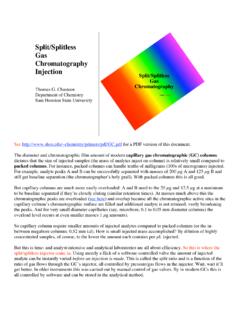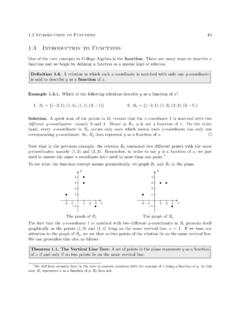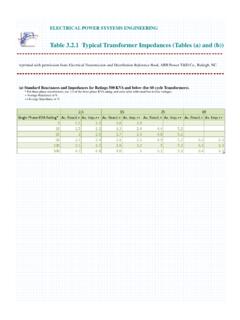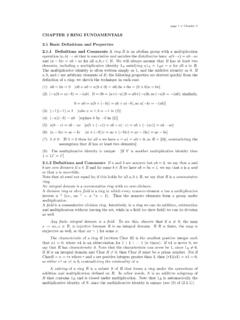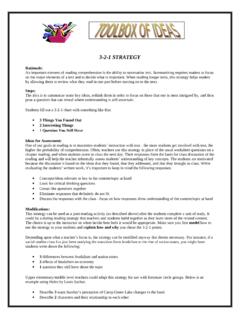Transcription of 2.3 Quadratic Functions - Sam Houston State University
1 188 Linear and Quadratic Quadratic FunctionsYou may recall studying Quadratic equations in Intermediate Algebra. In this section, we reviewthose equations in the context of our next family of Functions : the Quadratic functionis a function of the formf(x) =ax2+bx+c,wherea,bandcare real numbers witha6= 0. The domain of a Quadratic function is ( , ).The most basic Quadratic function isf(x) =x2, whose graph appears below. Its shape should lookfamiliar from Intermediate Algebra it is called aparabola. The point (0,0) is called thevertexof the parabola. In this case, the vertex is a relative minimum and is also the where the absoluteminimum value offcan be found.( 2,4)( 1,1)(0,0)(1,1)(2,4)xy 2 1121234f(x) =x2 Much like many of the absolute value Functions in Section , knowing the graph off(x) =x2enables us to graph an entire family of Quadratic Functions using the following Functions starting with the graph off(x) =x2and usingtransformations.
2 Find the vertex, State the range and find thex- andy-intercepts, if any (x) = (x+ 2)2 (x) = 2(x 3)2+ Sinceg(x) = (x+ 2)2 3 =f(x+ 2) 3, Theorem instructs us to firstsubtract2 fromeach of thex-values of the points ony=f(x). This shifts the graph ofy=f(x) to theleft2 units and moves ( 2,4) to ( 4,4), ( 1,1) to ( 3,1), (0,0) to ( 2,0), (1,1) to ( 1,1) and(2,4) to (0,4). Next, wesubtract3 from each of they-values of these new points. This movesthe graphdown3 units and moves ( 4,4) to ( 4,1), ( 3,1) to ( 3, 2), ( 2,0) to ( 2,3),( 1,1) to ( 1, 2) and (0,4) to (0,1). We connect the dots in parabolic fashion to Quadratic Functions189( 2,4)( 1,1)(0,0)(1,1)(2,4)xy 2 1121234f(x) =x2 ( 4,1)( 3, 2)( 2, 3)( 1, 2)(0,1)xy 4 3 2 1 3 11g(x) =f(x+ 2) 3 = (x+ 2)2 3 From the graph, we see that the vertex has moved from (0,0) on the graph ofy=f(x)to ( 2, 3) on the graph ofy=g(x). This sets [ 3, ) as the range ofg. We see thatthe graph ofy=g(x) crosses thex-axis twice, so we expect twox-intercepts.]
3 To findthese, we sety=g(x) = 0 and solve. Doing so yields the equation (x+ 2)2 3 = 0, or(x+ 2)2= 3. Extracting square roots givesx+ 2 = 3, orx= 2 3. Ourx-interceptsare ( 2 3,0) ( ,0) and ( 2 + 3,0) ( ,0). They-intercept of the graph,(0,1) was one of the points we originally plotted, so we are Following Theorem once more, to graphh(x) = 2(x 3)2+ 1 = 2f(x 3) + 1, we firststart byadding3 to each of thex-values of the points on the graph ofy=f(x). This effectsa horizontal shiftright3 units and moves ( 2,4) to (1,4), ( 1,1) to (2,1), (0,0) to (3,0),(1,1) to (4,1) and (2,4) to (5,4). Next, wemultiplyeach of oury-values first by 2 and thenadd1 to that result. Geometrically, this is a verticalstretchby a factor of 2, followed by areflection about thex-axis, followed by a vertical shiftup1 unit. This moves (1,4) to (1, 7),(2,1) to (2, 1), (3,0) to (3,1), (4,1) to (4, 1) and (5,4) to (5, 7).( 2,4)( 1,1)(0,0)(1,1)(2,4)xy 2 1121234f(x) =x2 (1, 7)(2, 1)(3,1)(4, 1)(5, 7)xy12345 6 5 4 3 2 11h(x) = 2f(x 3) + 1= 2(x 3)2+ 1 The vertex is (3,1) which makes the range ofh( ,1].)
4 From our graph, we know thatthere are twox-intercepts, so we sety=h(x) = 0 and solve. We get 2(x 3)2+ 1 = 0190 Linear and Quadratic Functionswhich gives (x 3)2=12. Extracting square roots1givesx 3 = 22, so that when weadd 3 to each side,2we getx=6 22. Hence, ourx-intercepts are(6 22,0) ( ,0) and(6+ 22,0) ( ,0). Although our graph doesn t show it, there is ay-intercept which canbe found by settingx= 0. Withh(0) = 2(0 3)2+ 1 = 17, we have that oury-interceptis (0, 17).A few remarks about Example are in order. First note that neither the formula given forg(x) nor the one given forh(x) match the form given in Definition We could, of course,convert bothg(x) andh(x) into that form by expanding and collecting like terms. Doing so, wefindg(x) = (x+ 2)2 3 =x2+ 4x+ 1 andh(x) = 2(x 3)2+ 1 = 2x2+ 12x 17. Whilethese simplified formulas forg(x) andh(x) satisfy Definition , they do not lend themselves tographing easily.
5 For that reason, the form ofgandhpresented in Example is given a specialname, which we list below, along with the form presented in Definition Standard and General Form of Quadratic Functions : Supposefis aquadratic function. Thegeneral formof the Quadratic functionfisf(x) =ax2+bx+c, wherea,bandcare real numbers witha6= 0. Thestandard formof the Quadratic functionfisf(x) =a(x h)2+k, wherea,handkare real numbers witha6= is important to note at this stage that we have no guarantees thateveryquadratic function canbe written in standard form. This is actually true, and we prove this later in the exposition, butfor now we celebrate the advantages of the standard form, starting with the following Vertex Formula for Quadratics in Standard Form: For the quadraticfunctionf(x) =a(x h)2+k, wherea,handkare real numbers witha6= 0, the vertex of thegraph ofy=f(x) is (h,k).We can readily verify the formula given Theorem with the two Functions given in After a (slight) rewrite,g(x) = (x+ 2)2 3 = (x ( 2))2+ ( 3), and we identifyh= 2andk= 3.
6 Sure enough, we found the vertex of the graph ofy=g(x) to be ( 2, 3). Forh(x) = 2(x 3) + 1, no rewrite is needed. We can directly identifyh= 3 andk= 1 and, sureenough, we found the vertex of the graph ofy=h(x) to be (3,1).To see why the formula in Theorem produces the vertex, consider the graph of the equationy=a(x h)2+k. When we substitutex=h, we gety=k, so (h,k) is on the graph. Ifx6=h, thenx h6= 0 so (x h)2is a positive number. Ifa >0, thena(x h)2is positive, thusy=a(x h)2+kis always a number larger thank. This means that whena >0, (h,k) is the lowest point on thegraph and thus the parabola must open upwards, making (h,k) the vertex. A similar argument1and rationalizing denominators!2and get common denominators! Quadratic Functions191shows that ifa <0, (h,k) is the highest point on the graph, so the parabola opens downwards, and(h,k) is also the vertex in this , we can apply the machinery in Section Since the vertex ofy=x2is (0,0), we candetermine the vertex ofy=a(x h)2+kby determining the final destination of (0,0) as it is movedthrough each transformation.
7 To obtain the formulaf(x) =a(x h)2+k, we start withg(x) =x2and first defineg1(x) =ag(x) =ax2. This is results in a vertical scaling and/or multiply the output bya, we multiply they-coordinates on the graph ofgbya, so the point(0,0) remains (0,0) and remains the vertex. Next, we defineg2(x) =g1(x h) =a(x h)2. Thisinduces a horizontal shift right or lefthunits4moves the vertex, in either case, to (h,0). Finally,f(x) =g2(x) +k=a(x h)2+kwhich effects a vertical shift up or downkunits5resulting in thevertex moving from (h,0) to (h,k).In addition to verifying Theorem , the arguments in the two preceding paragraphs have alsoshown us the role of the numberain the graphs of Quadratic Functions . The graph ofy=a(x h)2+kis a parabola opening upwards ifa >0, and opening downwards ifa <0. Moreover, the symmetryenjoyed by the graph ofy=x2about they-axis is translated to a symmetry about the vertical linex=hwhich is the vertical line through the line is called theaxis of symmetryofthe parabola and is dashed in the figures >0vertexa <0 Graphs ofy=a(x h)2+ a doubt, the standard form of a Quadratic function, coupled with the machinery in , allows us to list the attributes of the graphs of such Functions quickly and elegantly.
8 Whatremains to be shown, however, is the fact that every Quadratic functioncan be writtenin standardform. To convert a Quadratic function given in general form into standard form, we employ theancient rite of Completing the Square . We remind the reader how this is done in our next the Functions below from general form to standard form. Find the vertex,axis of symmetry and anyx- ory-intercepts. Graph each function and determine its (x) =x2 4x+ (x) = 6 x x23 Just a scaling ifa >0. Ifa <0, there is a reflection ifh >0, left ifh < ifk >0, down ifk <06 You should use transformations to verify this!192 Linear and Quadratic To convert from general form to standard form, we complete the , we verifythat the coefficient ofx2is 1. Next, we find the coefficient ofx, in this case 4, and take halfof it to get12( 4) = 2. This tells us that our target perfect square quantity is (x 2)2. Toget an expression equivalent to (x 2)2, we need to add ( 2)2= 4 to thex2 4xto createa perfect square trinomial, but to keep the balance, we must also subtract it.
9 We collect theterms which create the perfect square and gather the remaining constant terms. Putting itall together, we getf(x) =x2 4x+ 3(Compute12( 4) = 2.)=(x2 4x+ 4 4)+ 3 (Add and subtract ( 2)2= 4 to (x2+ 4x).)=(x2 4x+ 4) 4 + 3(Group the perfect square trinomial.)= (x 2)2 1(Factor the perfect square trinomial.)Of course, we can always check our answer by multiplying outf(x) = (x 2)2 1 to seethat it simplifies tof(x) =x2 4x 1. In the formf(x) = (x 2)2 1, we readily find thevertex to be (2, 1) which makes the axis of symmetryx= 2. To find thex-intercepts, wesety=f(x) = 0. We are spoiled for choice, since we havetwoformulas forf(x). Since werecognizef(x) =x2 4x+ 3 to be easily factorable,8we proceed to solvex2 4x+ 3 = gives (x 3)(x 1) = 0 so thatx= 3 orx= 1. Thex-intercepts are then (1,0) and(3,0). To find they-intercept, we setx= 0. Once again, the general formf(x) =x2 4x+ 3is easiest to work with here, and we findy=f(0) = 3. Hence, they-intercept is (0,3).
10 Withthe vertex, axis of symmetry and the intercepts, we get a pretty good graph without the needto plot additional points. We see that the range offis [ 1, ) and we are To get started, we rewriteg(x) = 6 x x2= x2 x+ 6 and note that the coefficient ofx2is 1, not 1. This means our first step is to factor out the ( 1) from both thex2andxterms. We then follow the completing the square recipe as (x) = x2 x+ 6= ( 1)(x2+x)+ 6(Factor the coefficient ofx2fromx2andx.)= ( 1)(x2+x+14 14)+ 6= ( 1)(x2+x+14)+ ( 1)( 14)+ 6(Group the perfect square trinomial.)= (x+12)2+2547If you forget why we do what we do to complete the square, start witha(x h)2+k, multiply it out, step bystep, and then reverse the pays off, here! Quadratic Functions193 Fromg(x) = (x+12)2+254, we get the vertex to be( 12,254)and the axis of symmetry tobex= 12. To get thex-intercepts, we opt to set the given formulag(x) = 6 x x2= , we getx= 3 andx= 2 , so thex-intercepts are ( 3,0) and (2,0).]




